Warehouse locations and bin labeling are, perhaps, the most underrated principles in warehouse management best practices. They don’t get a lot of attention because they’re not terribly interesting to talk about. That’s why I’m giving them some much-needed attention and telling you why you should give them a second look. If you want to sell more, pick more product, get merchandise out the door faster, and ultimately, reduce the costs of labor, miss-ships, and errors in your warehouse: look no further. What might be setting you back is your warehouse locations and how you label them.
The Argument for Showing Some Location Love
Let’s start from the beginning. Industry standards exist for a reason: they’ve been proven most efficient and cost-saving. After decades of trial-and-error, the warehouse industry has determined a clear right and wrong way of naming and labeling locations in a warehouse to benefit your inventory management. That’s not to say there are not a lot of opportunities to customize your locations based on your specific needs, however, there are some basic things you’ll want to get right from the get go.
When you name locations properly, you can take advantage tools and systems used in warehouse management systems like dynamic locations and interactive wave picking. These features allow you to get the most out of your warehouse space and employees. After all, having an optimized system means your pickers spend less time finding product and make fewer mistakes which is good for your bottom line.

How to Start Naming Your Locations
There are many ways to label warehouse locations but first let’s define some industry terms you’ll need to understand these best practices. Below are some terms used in the industry, however, keep in mind different terminology may be used. Find a warehouse location naming schema that works for you and be consistent. I’ll use industry standards in my description, but if you get confused about anything, please refer to the graphics throughout the article for help.
- A location is a labeled, designated area in a warehouse where a picker goes to retrieve product for an order. It’s typically identified with a series of alphanumeric barcodes that pickers use to scan in and out product to ensure accurate quantities and locations.
- A bin (also interchanged as a location) is any storage type within a location that contains one or more spaces or slots for product (i.e. a bin of nails, a bin containing slots of a particular document type, etc.). Typically, it is the most specific a warehouse location can get.
- The next level of location naming is by shelf (AKA row). This is categorized as the horizontal space spanning across a rack.
- Racks (AKA units or section) can be thought of as large sections of shelving units that store your product. Depending on the warehouse, racks/units might be identified as an entire shelving unit spanning one side of an aisle or as small sections within a long until of shelving. You can imagine the latter way as a bunch of bookcases lined in a row, and each bookcase is its own rack within the row of racks (see infographic).
- The next, most general way to specify your location is by aisle, which is just defined by the walking space between your racks.
Subscribe and receive tips that build trust with and delight your buyer
Best Practices
Warehouse location labeling is a tricky business. The organization of location codes as well as what locations are actually called can (and usually do) differ greatly between warehouses. There are, however, a few industry standards you should follow in order to prevent needing to rename all your shelves later on and alleviate potential confusion for your pickers.
- Number shelves from the ground up. This way, if you add height to your shelves as you grow, you don’t have to relabel your shelves. Otherwise, if you have a rack with four shelves with the top shelf given the number one and the bottom shelf being number four, if you want to build up and add locations, your new location (let’s say shelf five) would be on top of shelf one.
- It is best practice that when setting up alphanumeric locations to use a zero in all numbers less than ten (i.e. 01, 02, 03, etc.). This will allow the system to accurately read the locations alphanumerically.
- Be consistent. There’s nothing that will screw up your system and your employees faster than having an inconsistent method of labeling.
If you keep these in mind, you’ll save yourself a lot of headaches, time, and money over time!
Location Labeling
The thing about naming warehouse locations is the information that is included is dependent on the warehouse they’re found in. No two warehouses will necessarily use the system as the other. A warehouse selling large bulky lawnmowers will unlikely need to identify based on the unit/ rack, while a warehouse with primarily small products, like computer parts, may need to get as specific as possible in order to locate items amidst a wall of hundreds of products.
I’ll go into the details you’ll need to label the majority of your warehouse below, but if you’d like another example of how this is put into practice, please check out our support page here.

Rack Labeling
The two most common ways of labeling racks are serpentine and standard. And in fact, most experts you come across will argue for the case of a serpentine system. Why? Because when provided with a picklist that is in order by location, pickers can weave (like a snake) up and down the aisle and collect products for several orders without having to double back or skip around their picklist. It means a more organized and efficient route for pickers to follow.
A serpentine method for labeling racks/units would look something like this:
Aisle 01
Unit AA | Unit AB | Unit AC
Unit AF | Unit AE | Unit AD
Aisle 02
Unit BA | Unit BB | Unit BC
Unit BF | Unit BE | Unit BD
Aisle 3
As you can see, a picklist would naturally guide a picker up and down an aisle from unit AA to unit AC and then back to AA on the next aisle.
Alternatively, a standard method would look like this:
Aisle 01
Unit AA | Unit AB | Unit AC
Unit AA | Unit AB | Unit AC
Aisle 02
Unit BA | Unit BB | Unit BC
Unit BA | Unit BB | Unit BC
Aisle 3
This means pickers would be inclined to skip around on the picklist or be forced to travel inefficiently through the warehouse to collect product for orders.
Shelf Labeling
The industry preferred method of shelf labeling is by section (see graphic). Depending on the warehouse and their needs, you might choose to put the shelf value in the last position of your location code. This would mean your shelves are organized “vertically” or “by shelf”. Warehouses may choose to do this if they have irregularly shaped or large items or some other reason to dislike this typical organization scheme.
However, most locations are divided by the following elements: aisle-unit/rack-shelf/row-bin.
Each shelf within a unit should count up from one and continue numerically until you reach the end of a shelf. For instance, in the example below, you can see shelf four and shelf five starts with bin one and end at bin four. This way, the picker knows that if he’s looking for bin two, it will always be in the second position, regardless of which shelf it’s on.
Conclusion
As you can see, a lot goes into naming locations, and due to how highly customizable it is, you can really get as specific or general as you want. While this can be a good thing, with a well-planned schema, undertaking this kind of project is understandably daunting. But don’t panic. As aforementioned, location labeling varies from warehouse to warehouse, so don’t worry if your location labeling is different from the way I’ve described above.
Or, you might be panicking if you’re here researching the best method for labeling your growing warehouse. In either case, I understand. I hope I’ve alleviated some of the anxiety and research associated with this project and you can use the graphics for reference in labeling your own warehouse. As always, if you have any questions, feel free to reach out to anyone in the SkuVault team or comment below. Good luck!




